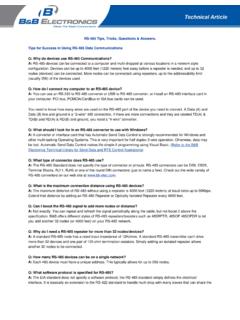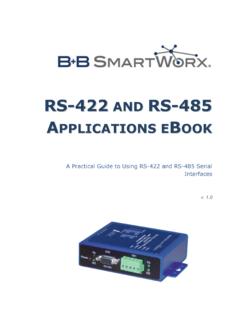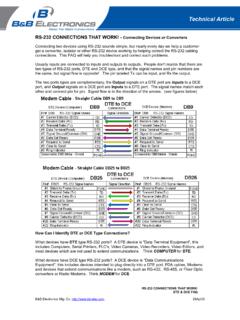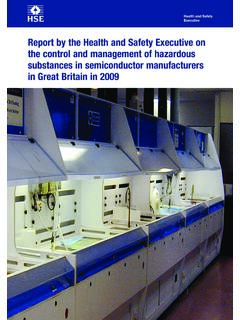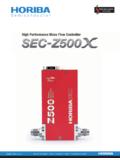Transcription of MTBF, MTTR, MTTF & FIT Explanation of Terms
1 mtbf , mttr , mttf & FITE xplanation of TermsPurposeThe intent of this White Paper is to provide an understanding of mtbf and other product reliability methods. Understanding the methods for the lifecycle prediction for a product enables the customer to consider the tangible value of the product beyond set-features before purchasing , mttr , mttf and FIT are reliability Terms based on methods and procedures for lifecycle predictions for a product. Customers often must include reliability data when determining what product to buy for their application. mtbf (Mean Time Between Failure), mttr (Mean Time To Repair), mttf (Mean Time To Failure) and FIT (Failure In Time) are ways of providing a numeric value based on a compilation of data to quantify a failure rate and the resulting time of expected performance.
2 The numeric value can be expressed using any measure of time, but hours is the most common unit in the AuthorSusan Stanley, Senior Technical Support Engineer, IMC NetworksSusan Stanley has spent the last 16 years in engineering and customer service at technology-related companies such as Brother International, Citoh and currently, IMC Networks. Her working experience encompasses a wide range of technologies, including Operating Systems, supporting and troubleshooting peripherals such as IP-based Multi-Function equipment and Scanners, web-coding for an Intranet and utilizing the application of Visual Basic to modify code. Certifi ed as a technical trainer, she has trained all new employees for product knowledge as well as developing a comprehensive FAQ system for internal , Susan Stanley heads the technical support and customer service activities for IMC Networks, providers of fi ber optic access and media conversion solutions for Enterprise, Government and Service Providers LANs, First-Mile FTTx Networks and Metropolitan Area Networks.
3 She is key in establishing the initial customer service contact and resolving critical issues for IMC Networks products. Having the ability to convey technical information into layman s terminology is a critical element in quickly resolving an end-user s product issues and questions. She provides feedback from the customer base to the Engineering team, which can result in product improvements or , mttr , mttf & FITE xplanation of TermsIntroductionMTBF, mttr , mttf and FIT Mean Time Between Failure ( mtbf ) is a reliability term used to provide the amount of failures per million hours for a product. This is the most common inquiry about a product s life span, and is important in the decision-making process of the end user.
4 mtbf is more important for industries and integrators than for consumers. Most consumers are price driven and will not take mtbf into consideration, nor is the data often readily available. On the other hand, when equipment such as media converters or switches must be installed into mission critical applications, mtbf becomes very important. In addition, mtbf may be an expected line item in an RFQ (Request For Quote). Without the proper data, a manufacturer s piece of equipment would be immediately disqualifi Time To Repair ( mttr ) is the time needed to repair a failed hardware module. In an op-erational system, repair generally means replacing a failed hardware part. Thus, hardware mttr could be viewed as mean time to replace a failed hardware module.
5 Taking too long to repair a prod-uct drives up the cost of the installation in the long run, due to down time until the new part arrives and the possible window of time required to schedule the installation. To avoid mttr , many com-panies purchase spare products so that a replacement can be installed quickly. Generally, however, customers will inquire about the turn-around time of repairing a product, and indirectly, that can fall into the mttr Time To Failure ( mttf ) is a basic measure of reliability for non-repairable systems. It is the mean time expected until the fi rst failure of a piece of equipment. mttf is a statistical value and is meant to be the mean over a long period of time and a large number of units.
6 Technically, mtbf should be used only in reference to a repairable item, while mttf should be used for non-repairable items. However, mtbf is commonly used for both repairable and non-repairable In Time (FIT) is another way of reporting mtbf . FIT reports the number of expected failures per one billion hours of operation for a device. This term is used particularly by the semiconductor industry but is also used by component manufacturers. FIT can be quantifi ed in a number of ways: 1000 devices for 1 million hours or 1 million devices for 1000 hours each, and other combinations. FIT and CL (Confi dence Limits) are often provided together. In common usage, a claim to 95% confi dence in something is normally taken as indicating virtual certainty.
7 In statistics, a claim to 95% confi dence simply means that the researcher has seen something occur that only happens one time in twenty or less. For example, component manufacturers will take a small sampling of a component, test x number of hours, and then determine if there were any failures in the test bed. Based on the number of failures that occur, the CL will then be provided as Methods & StandardsSeveral prediction methods over time have been developed to determine reliability, but the two standards most often used when compiling reliability data for media converters are: the MIL-HDBK-217F Notice 2 (Military Handbook) and Bellcore TR332.
8 The MIL-HDBK-217 encompasses two ways to predict reliability: Parts Count Prediction (used to predict the reliability of a product in its early development cycle) and Parts Stress Analysis Prediction (used later in the development cycle, as the product nears production). This is how the famous bathtub curve so adeptly illustrates the unit failure in proportion to a period of time. Other methods are applicable to the telecom industry while still others are useful for analyzing how failure modes would impact a product. The challenge is choosing the method based on the product s When the failure rate needs to be as low as possible, especially for mission critical systems, for example, utilizing mtbf data to ensure maximum uptime for an installation.
9 It is a common misconception, however, that the mtbf value is equivalent to the expected number of operating hours before a product fails, or the service life . There are several variables that can impact failures. Aside from component failures, customer use/installation can also result in failure. For example, if a customer misuses a product and then it malfunctions, should that be considered a failure? If a product is delivered DOA because it was not properly packaged, is that a failure? The mtbf is often calculated based on an algorithm that factors in all of a product s components to reach the sum life cycle in hours. In reality, depreciation modes of the product could limit the life of the product much earlier due to some of the variables listed above.
10 It is very possible to have a product with an extremely high mtbf , but an average or more realistic expected service life. mtbf = 1 FR1 + FR2 + FR3 + ..FRnwhere FR is the failure rate of each component of the system up to n componentsMTBF is not just a simple formula. A person certifi ed and educated in calculating mtbf is a good investment. That person must review the mtbf for every component as well as other factors such as operating temperature range, storage temperature range, the mtbf calculation, Quality Assurance Managers should track all reported fi eld failures as well as the root cause of those product failures to produce a true snapshot of a product s service life.
